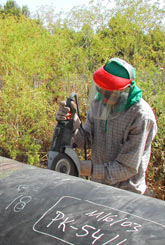In March, the European Commission released a communication detailing an ambitious strategy whereby the EU would help maintain the campaign against climate change. This document emphasises several main challenges, including the Copenhagen Accord's immediate application in EU countries and actively engaging other Bodies and countries to help forge a legally-binding agreement in Cancun.
Over the course of 2010, CO2 prices (US spot) oscillated between 11 and 16 euros per tonne. Low for the majority of international bodies looking to seal a firmer commitment to reduce emissions, yet consistent with the widespread slump in economic activity.
In June, the data concerning 2009's global emissions were released. 2009's figures indicate a 1% reduction over data from 2008. A sharp increase in emissions from emerging countries cancelled out the decline among developed countries. Total emissions in 2009 were 40% higher than in 1990, the Kyoto Protocol's benchmark year. In Europe, emissions fell 11% in 2009, in accordance with data collected by Point Carbon analysts.
In July, the US Senate delayed the Climate Change Law. This project will not be considered for discussion until 2011. In this country, experts have voiced the opinion that natural gas should figure among the most valid options to help meet the target of reducing greenhouse gases.
As of late September, the world's total wind energy came to 200 GW. The Global Wind Energy Council estimates that wind energy increased by 40 GW in 2010. This institution approximates that the world's total wind energy will have reached 400 GW by 2014 and 2,000 GW by 2020.
The 16th International Climate Change Conference (COP 16) was held in Cancun between 29 November and 10 December. According to the preparatory work's initial set-up, industrialised countries are to reduce their carbon dioxide emissions by between 75% and 95% by 2050, with respect to levels recorded in 1990.
The Cancun Accord represents a balanced commitment between the distinct interests within the United Nations' system. The package's key aspects include:
- Acknowledgement, for the first time in a UN document, that global warming cannot rise by more than 2ºC over the pre-industrial temperature, and the establishment of a process to set a date whereon global emissions reach their maximum limit, as well as a global emissions reduction target for 2050.
- Confirmation that developed countries have agreed to mobilise 100 thousand million dollars in annual financing, until the year 2020, for developing countries' climate, and the establishment of a Green Fund, through which a large part of this financing will be channelled.
- Implementation of a REDD-plus mechanism that allows for initiatives to reduce emissions from deforestation and forest degradation in developing countries.
- Establishment of a technology mechanism, including an Executive Technology Committee and Climate Technology Centre and Network, which furthers the development and transfer of technology.
Desertec Industrial Initiative (DII) is the largest scheme currently in-place to develop the possibility of exploiting renewable energy sources (primarily solar) in Northern Africa. It aims to supply 15% of Europe's electrical needs by 2050, in addition to covering local needs.
With respect to capturing and storing CO2, pilot and even commercial plants are making progress. However, it is worth mentioning that underground CO2 storage facilities could prevent, by 2030, emissions representing 15% of the reductions required within the European Union.

-
 ENAGÁS
ENAGÁS

